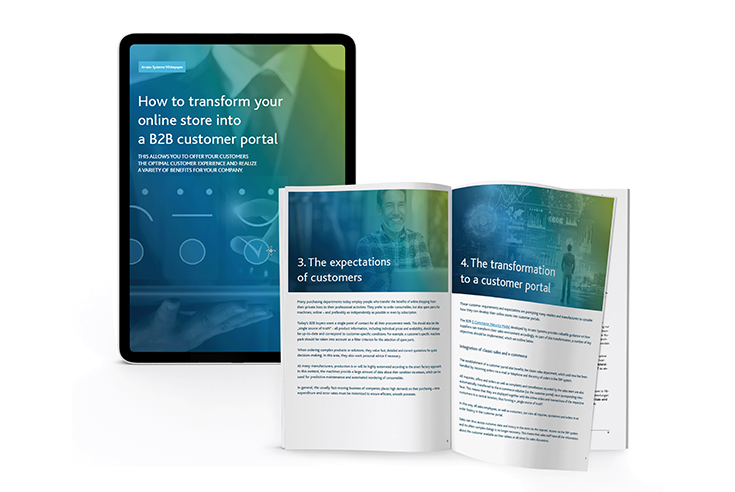
Transformation from B2B Shop to Customer Platform
Better customer experience is also becoming increasingly important in B2B business
Whitepaper: How to transform your online shop into a B2B customer portal
Download now for free!
In B2B Trade, the Trend Is Clearly Moving Towards E-commerce Customer Portals
The simple online store has also had its day in B2B commerce. After all, customers expect the services familiar from B2C e-commerce to be perfectly orchestrated in the B2B sector as well. So it's clear that anyone who wants to sell products and services to companies today successfully should offer a customer portal. The good news is that it should pay off because customers spend more online.
In e-commerce, the work-life balance has practically already been achieved in a figurative sense. B2C and B2B e-commerce have converged - B2B customers today expect the customer experience they are also familiar with from their private lives. The "anytime, anywhere" promise from B2C retail should also be delivered in B2B commerce.
This is supported by the "Global B2B Pulse" study by management consultants McKinsey & Company. According to this study, around two-thirds of corporate shoppers want digital customer service options or, better yet, digital self-service.
This should be possible across all channels. According to the study, customers today expect to be able to contact retailers via at least ten channels - in 2016, five channels were still sufficient.
This expectation is also consistently demanded. In the study, it became clear that many respondents would actively look for another provider if a certain experience was unavailable.
Here Are a Few Examples
- Consistent customer experience across all channels: 72%
- Real-time, around-the-clock customer service: 72%
- Performance guarantee with complete refund: 78%
- Product availability viewable online: 74%
- Ability to purchase through any channel: 72%
- Easy checkout via smartphone: 65%
- Single Sign On (SSO) across all websites and apps: 63%

Scope: 13-page whitepaper
Reading time: approx. 15 minutes
From Online Store to Customer Portal
Given these customer expectations, the days of simple web stores are over, even in B2B e-commerce. Anyone who wants to trade successfully with companies today should expand the online store into a customer portal.
This is not only about offering customers the expected customer experience but also about:
Many retail companies find it challenging to define their e-commerce strategy given the many options. Arvato Systems has developed a B2B e-commerce maturity model for this purpose. Four development stages and six dimensions depict the entire transformation path from a simple online store to a customer portal. This allows retailers to determine the status quo of their e-commerce activities and verify their goals.
This model is additionally explained in detail in a comprehensive whitepaper.
It Describes the Essential Functions That a B2B Customer Portal Should Offer
Integration of traditional sales and e-commerce
According to the McKinsey study, such hybrid sales channels are now one of the options preferred by B2B retailers - 62 percent of respondents already use them. Salespeople have the same responsibilities as employees in traditional field sales but use digital features such as video conferencing. Sales are made via self-service portals.
Maximum personalization also in B2B e-commerce
Personalization of information and offers is becoming increasingly crucial in B2B commerce. It is an essential means of increasing customer loyalty. Personalization should be based on the functions familiar from the B2C sector - examples include options such as "Customers also bought", "Matching products," or "More from the range".
New business approaches and value-added services
Additional functions beyond the standard ordering process increase the benefits of the portal for customers. Possible options include customer-specific ordering processes, individualized shipping, delivery logistics, or even the recording of fill levels and the resulting procurement processes.
Direct to Consumer
The direct-to-consumer model, or D2C for short, is also becoming increasingly established in the B2B sector. This refers to the direct sale of products to end consumers. Most of these products are commodity items, but services and maintenance services are also offered this way. D2C requires the optimization and enhancement of product data.
Product as a Service
In this sales model, customers do not buy the product but pay a recurring usage fee - retailers or manufacturers remain owners of the product. Physical products are usually combined with software and services.
Customer Self Service
Today, customers prefer to initiate service processes such as complaints, cancellations, or returns. On the retailer side, this saves an enormous amount of time and money. In addition, evaluations of the services provide the basis for further improvement of internal processes.
Data-driven AI services
During all these digital sales activities, large amounts of data are naturally generated - information about the customers, the products and services purchased, for example. These can be used in various ways for AI-powered optimization of e-commerce processes.
Customers Spend More Online
All these efforts are paying off - an indication of this is provided by the McKinsey study already mentioned. According to this, in December 2021, 20 percent of B2B buyers were willing to spend between 500,000 and five million US dollars for a single interaction via remote or self-service channels. That figure was down from 16 percent in February 2021. In addition, seven percent of buyers are willing to complete transactions worth more than $5 million entirely online.
